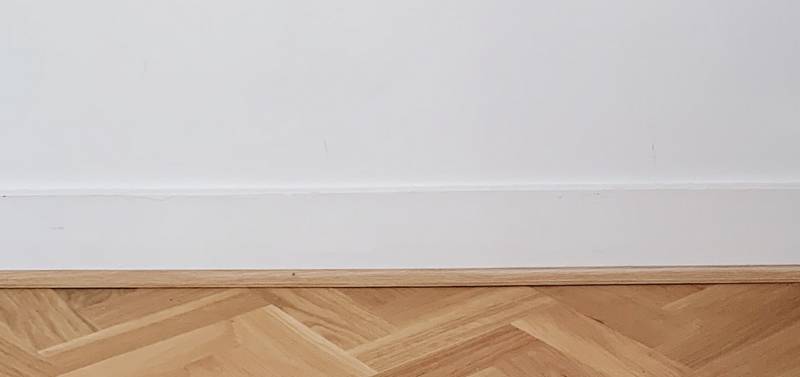Dog Chewing Baseboards? How to Stop, Protect, & Fix!
Dog owners face a myriad of behavioral issues, but one that leaves many scratching their heads is their dog chewing baseboards. Not only can this habit result in unsightly damage to your home, but it can also pose a risk to your dog’s health. Don’t fret; we’re here to help you navigate through this issue.
This comprehensive guide covers various aspects of this problem, from understanding why dogs develop a taste for baseboards to strategies to deter this destructive behavior. We’ll also discuss how to protect your baseboards and repair any damage that’s been done. Additionally, we’ll cover peculiar scenarios like your dog suddenly deciding the baseboards are a tasty treat when home alone.
Ready to tackle this issue? Let’s dive in below!
How to Stop Dog From Chewing Baseboards

To stop your dog from chewing on baseboards, a simple homemade deterrent spray can do wonders. Along with adequate mental and physical stimulation, this easy solution can help keep your pup’s teeth away from your woodwork. Here’s how to create and use this deterrent:
- Create the Deterrent Spray: In a spray bottle, mix together equal parts of distilled white vinegar and water. This mixture creates a scent that most dogs find unpleasant, but don’t worry – the smell of vinegar dissipates quickly for humans.
- Apply the Spray: Spritz the vinegar solution lightly onto the baseboards. You just want to cover the length, you don’t need to saturate.
- Dry the Baseboards: Use a slightly damp cloth to wipe your boards clean, then allow them to air dry.
Though the scent of vinegar will vanish for human noses within an hour, dogs can still pick it up for a good while longer, which helps deter them from the sprayed areas.
These steps will get your dog to stop chewing the baseboards, but it’s important to remember that the underlying behavioral issue (anxiety) that was causing all of this to begin with will still be present. And until you address it, any positive changes you see are only going to be temporary.
“So, how do I make them last then?”
By getting your dog to truly choose to follow your direction, that’s how. I tried many times to write out how you can do that before deciding it made more sense to just link you to the free video series that explains it better than I’d ever be able to.
The series is by a man named Dan who is one of the world’s leading dog obedience trainers. In it, he teaches you how to put an end to things like when your dog chews baseboards and all other misbehavior using his fast and easy-to-follow methods.
In the first video, Dan will reveal to you why the two most common methods of dog training only doom you to failure. You can watch the video now by clicking here. Follow the proven system he’ll show you in his series and you’ll never have to spend another second worrying about your dog chewing baseboards ever again!
What to Put On Baseboards to Keep Dogs From Chewing

If your dog has been chewing on your baseboards, you’re likely seeking a solution to deter this behavior. Here are some things you can put on your baseboards to discourage your dog from chewing:
- White Vinegar: Diluted white vinegar is a safe and effective deterrent for dogs. Make a 50/50 mix in a spray bottle. Apply, then wipe away with a slightly damp cloth. Allow to air dry. The smell will go away shortly but your dog has a very strong sense of smell and should remain repelled.
- Bitter Sprays: There are sprays available that have a bitter taste, designed to deter dogs from chewing. They’re safe for dogs and can be sprayed directly onto the baseboards.
- Protective Covers: You can install protective covers or guards on your baseboards. These are typically made of plastic or metal and can prevent your dog from getting to the wood.
Remember, these are temporary solutions. It’s crucial to address the root cause of the chewing to find a long-term solution. Training, appropriate chew toys, and plenty of physical and mental stimulation are typically the most effective ways to curb unwanted chewing. Learn how to take care of what’s causing everything by going back to the first section of this article.
Not taking care of the actual problem will just mean that your problem shows up elsewhere (and you can’t spray down everything). You’ll soon probably find that your dog chews on window sills, chews on plastic, chews on metal, and maybe even chews on mulch.
Why Do Dogs Chew Baseboards?
Dogs may chew on baseboards for several reasons, such as anxiety, boredom, and teething. It’s important to understand the root cause to effectively address the behavior. Here are a few reasons why dogs might chew on baseboards:
- Anxiety: Dogs often turn to chewing when they’re stressed or anxious. Chewing can serve as a self-soothing behavior that distracts them from their anxious feelings. Separation anxiety, changes in the environment, or a lack of socialization can all contribute to this.
- Boredom: If your dog is not getting enough physical and mental stimulation, they might resort to destructive behaviors such as chewing on baseboards. Dogs need regular exercise and mental stimulation to stay happy and healthy. A bored dog might find that chewing on a baseboard provides a form of entertainment.
- Teething: For puppies, chewing is a natural behavior that helps alleviate the discomfort of teething. If your puppy is chewing on baseboards, it could be because their gums are sore and the pressure from chewing provides relief.
Understanding the root cause of the chewing behavior is essential for effectively addressing and resolving the issue. Go back to the first section of this article now where we’ll explain how you can do all of that.
Puppy Chewing Baseboards: Is It a Phase?
If your puppy is chewing on your baseboards, you might be wondering if this is just a phase or a sign of a more serious issue. Generally, for puppies this behavior can be attributed to teething, boredom, anxiety, or a lack of appropriate chew toys.
Teething
When puppies are teething, they’ll chew on just about anything to relieve the discomfort. If your puppy has found your baseboards, it’s likely because the hard surface feels good on their sore gums.
Boredom
Puppies are full of energy, and if they aren’t given enough mental and physical stimulation, they can start chewing on things like baseboards out of boredom. This destructive behavior can be their way of trying to entertain themselves.
Anxiety
Puppies experience stress and worry just like older dogs, which is no surprise with all the new things they’re experiencing. Some will seek to self-soothe if they get anxious by chewing on your baseboards and other easily accessible objects.
Lack of Appropriate Chew Toys
Your puppy might also be chewing on your baseboards simply because they don’t have enough appropriate things to chew on. Providing a variety of puppy-safe chew toys can give them an outlet for their chewing needs.
Is It a Phase?
In most cases, puppies grow out of the excessive chewing phase as they mature and once teething is over. However, it’s important to address this behavior early on to prevent it from becoming a long-term habit. You can learn more about how to do that by going back to the first section of this article now.
Addressing the Behavior
To deter your puppy from chewing on your baseboards, make sure they have plenty of appropriate chew toys. If they start chewing on a baseboard, redirect them to one of their toys. Additionally, ensure your puppy is getting enough exercise and mental stimulation to prevent boredom. If necessary, use a pet-safe deterrent spray on your baseboards to make them less appealing.
Remember, patience and consistency are key when dealing with a teething or bored puppy. It might be a trying phase, but with the right strategies, it can be managed effectively.
Dog Chewing On Baseboard When Left Home Alone
When your dog chews on the baseboard when left home alone, it’s often a sign of separation anxiety or boredom. Both scenarios can lead to destructive behaviors, including chewing on baseboards. Let’s take a closer look at these issues:
- Separation Anxiety: Some dogs become anxious when left alone. They might express this anxiety through destructive behaviors like chewing on baseboards. They do this in an attempt to alleviate their stress.
- Boredom: Dogs, especially active breeds, need mental and physical stimulation. If they don’t get enough, they might resort to activities like chewing to keep themselves entertained.
While the immediate solution might be to deter your dog from chewing the baseboards, this doesn’t solve the underlying problem. It’s important to address the root cause, whether that’s separation anxiety or boredom.
Remember, applying deterrents to all your baseboards can be a tedious process and is more of a quick fix than a long-term solution. To learn how to tackle this at the root (and also how to protect your baseboards), go back to the first section of this article now.
Dog Eating Baseboards: What’s Happening?
If your dog is eating baseboards, it’s likely a manifestation of a condition known as pica, which is characterized by the ingestion of non-food items. This behavior can be prompted by various factors, including stress, boredom, or even underlying medical conditions.
One of the most common reasons dogs engage in destructive behaviors like eating baseboards is due to boredom or lack of mental stimulation. Dogs are intelligent creatures and require both physical and mental exercise. When they don’t get enough of either, they may resort to behaviors like chewing and eating baseboards.
Stress or anxiety can also lead to this behavior. Dogs may chew or eat items around the house as a way to self-soothe or cope with stressful situations.
Here are a few more reasons why your dog eats baseboards:
- Teething: In puppies, teething can lead to increased chewing. This behavior often subsides as they grow, but it’s important to provide appropriate chew toys during this stage.
- Dietary deficiencies: Sometimes, dogs start eating non-food items due to a deficiency in their diet. If you suspect this might be the case, it’s crucial to consult with a vet.
- Medical issues: Certain health problems can lead to pica. If you notice other signs of illness alongside this behavior, a vet visit is necessary.
Eating baseboards can be dangerous for dogs as it can lead to potential health risks, like intestinal blockages. If your dog is engaging in this behavior, it’s important to seek help from a professional dog trainer or behaviorist.
They can provide strategies to manage the behavior and help identify any potential underlying issues. Remember, patience and understanding are key in addressing these behaviors.
How to Protect Baseboards From Dogs
If you’re concerned about your dog damaging your baseboards, there are proactive steps you can take to protect them. Here are some suggestions:
- Use a Deterrent: You can use a safe deterrent like diluted white vinegar or a commercial bitter spray to discourage your dog from chewing. Test any product on a small, hidden area first to ensure it doesn’t discolor your wood.
- Install Protective Covers: Protective covers or guards made from plastic or metal can be installed on your baseboards to prevent your dog from reaching the wood.
- Provide Alternatives: Offer your dog plenty of chew toys or bones to keep them occupied and satisfy their need to chew. This can divert their attention away from your baseboards.
- Regular Exercise and Mental Stimulation: Ensuring your dog gets plenty of physical activity and mental stimulation can help reduce unwanted chewing. A tired dog is generally a well-behaved dog!
While these measures can help protect your baseboards, they’re not foolproof. And applying deterrents or covers to all your baseboards can be a laborious task. So, addressing the root cause of the chewing, such as anxiety or boredom, is the most effective solution. Go back to the first section of this article now and we’ll teach you how to do that.
How to Fix Chewed Baseboards
If your dog has already chewed your baseboards, don’t panic. Here’s a step-by-step guide to fixing the damage:
- Assess the Damage: First, you need to assess the extent of the damage. If it’s minor, you might be able to fix it yourself. But if the damage is severe, you may need to replace the entire baseboard or call in a professional.
- Gather Your Materials: You’ll need wood filler or putty, a putty knife, sandpaper, and paint that matches your baseboard.
- Apply Wood Filler: Use a putty knife to apply wood filler to the damaged area. Overfill the chewed area slightly, as the filler will shrink as it dries.
- Let It Dry: Allow the wood filler to dry completely. This can take a few hours to a whole day, depending on the product.
- Sand It Down: Once the wood filler is dry, use sandpaper to smooth the surface until it’s level with the rest of the baseboard.
- Paint Over It: Finally, paint over the repaired area with a paint that matches your baseboard. You may need to apply several coats to get the right color match.
Remember, this is a temporary fix. To prevent future damage, you’ll need to find a way to stop your dog from chewing the baseboards. Find out how you can do that by going back to the first section of this article now where we’ll explain everything.
I’m sure you’re sick of your dog’s destructive chewing, so I’ll let you get started on things now. Best of luck with everything, and thank you for checking out our article “Dog Chewing Baseboards? How to Stop, Protect, & Fix!”





